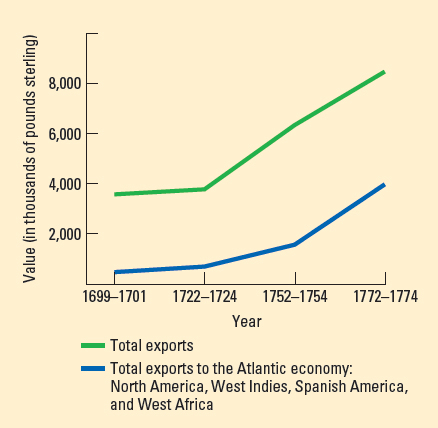Understanding World Societies:
Printed Page 573
The Atlantic Economy
European economic growth in the eighteenth century was spurred by the expansion of trade across the Atlantic Ocean. Commercial exchange in the Atlantic is often referred to as the triangle trade, designating a three-

Moreover, the Atlantic economy was inextricably linked to trade with the Indian and Pacific Oceans. The rising economic and political power of Europeans in the eighteenth century thus drew on the connections they established between the long-

While trade between England and Europe stagnated after 1700, English exports to Africa and the Americas boomed and greatly stimulated English economic development. (Source: Data from R. Davis, “English Foreign Trade, 1700–
Over the course of the eighteenth century the economies of European nations bordering the Atlantic Ocean relied more and more on colonial exports. In England sales to the mainland colonies of North America and the West Indian sugar islands soared from £500,000 to £4 million (Figure 19.1). Exports to England’s colonies in Ireland and India also rose substantially from 1700 to 1800.
At the core of this Atlantic world was the misery and profit of the Atlantic slave trade (see “The Transatlantic Slave Trade” in Chapter 20). The brutal practice intensified dramatically after 1700 and especially after 1750 with the growth of trade and demand for slave-
The French also profited enormously from colonial trade in the eighteenth century, even after losing their vast North American territories to England in 1763. The Caribbean colonies of Saint-
The third major player in the Atlantic economy, Spain, also saw its colonial fortunes improve during the eighteenth century. Its mercantilist goals were boosted by a recovery in silver production. Spanish territory in North America expanded significantly in the second half of the eighteenth century. At the close of the Seven Years’ War (1756–